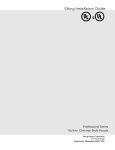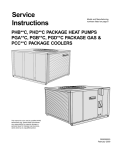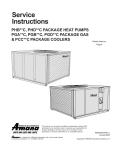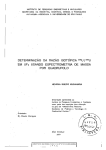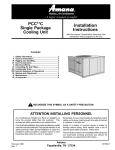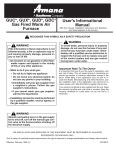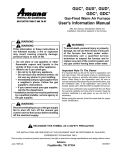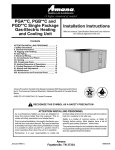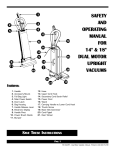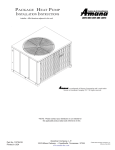Download Amana PHB**C Instruction manual
Transcript
PHB**C and PHD**C Single Package Installation Instructions Heat Pump Affix this manual, Specification Sheet and User Information manual adjacent to the unit. Heating and Cooling Unit Contents I. Safety Information ................................................ 2 II. General Information ............................................ 2 III. Rigging and Handling ......................................... 3 IV. Duct Connections ............................................... 4 V. Electrical Wiring .................................................. 4 Vl. Circulating Air and Filters .................................. 5 VII. Condensate Drain ............................................. 6 VIII. Sequence of Operations .................................. 6 IX. Startup and Adjustment ..................................... 6 X. Maintenance ....................................................... 7 XI. Accessories and Functional Parts ...................... 7 RECOGNIZE THIS SYMBOL AS A SAFETY PRECAUTION ATTENTION INSTALLING PERSONNEL As a professional installer you have an obligation to know the product better than the customer. This includes all safety precautions and related items. Remember, it is your responsibility to install the product safely and to know it well enough to be able to instruct a customer in its safe use. Prior to actual installation, thoroughly familiarize yourself with this Instruction Manual. Pay special attention to all safety warnings. Often during installation or repair it is possible to place yourself in a position which is more hazardous than when the unit is in operation. Safety is a matter of common sense...a matter of thinking before acting. Most dealers have a list of specific good safety practices...follow them. January 1997(1) The precautions listed in this Installation Manual should not supersede existing practices but should be considered as supplemental information. Amana Refrigeration, Inc. Fayetteville, TN 37334 10730405 Locating The Unit I. Safety Information Important WARNING To prevent death, personal injury, property damage or equipment damage, the following points must be observed when installing the unit. To The Installer Before installing this unit please read this manual and the Specification Sheet to familiarize yourself on the specific items which must be adhered to such as maximum external static pressure to unit, air temperature rise, minimum or maximum CFM and motor speed connections. All Installations: Ground Level Installations Only: • When the unit is installed on the ground adjacent to the building, a level concrete (or equal) base is recommended. Prepare a base the same physical size as the unit or slightly larger and 3 inches thick. To The Owner It is important to complete the owner registration card and mail it immediately. This will assist Amana in contacting you if any service or warranty information should change in the future. When completing the registration card, be sure to include the Model, Manufacturing and Serial Numbers, plus the installation date. • The base should also be located where no runoff of water from higher ground can collect in the unit. The warranty certificate is also supplied with the unit. Read the warranty carefully and note what is covered. Keep the warranty certificate in a safe place so you can find it if necessary. Rooftop Installations Only: • To avoid possible personal injury or property damage, the roof must have sufficient structural strength to carry the weight of the unit(s) and snow or water loads as required by local codes. If additional operating instructions are required, call the dealer where the purchase was made. Keep this literature in a safe place for future reference. • If horizontal air delivery is used, the unit may be installed directly on wood floors or on Class A, Class B, or Class C roof covering material. WARNING • To avoid possible personal injury, a safe, flat surface for service personnel must be provided. To prevent death, personal injury or property damage, do not use this unit if any part of the unit has been under water. Immediately call a qualified service technician to inspect the unit and to replace any part of the control system which has been under water. • If vertical air discharge is used and the unit is installed on combustible flooring or class A, B, or C roofing material, then the Amana roof curb (PRC01*) is required. II. General Information This unit is approved only for an outdoor installation. To assure that your unit operates safely and efficiently, it must be installed, operated, and maintained in accordance with these installation and operating instructions, all local building codes and ordinances. WARNING To prevent death, personal injury, or property damage due to improper installation, adjustments, alterations, service or maintenance, when servicing or performing maintenance to this unit consult this manual, the service manual, a qualified installer, a service agency. The heating and cooling capacities of the unit should be greater than or equal to the design heating and cooling loads of the area to be conditioned. The loads should be calculated by an approved method or in accordance with A.S.H.R.A.E. Guide or Manual J - Load Calculations published by the Air Conditioning Contractors of America. Obtain from: WARNING American National Standards Institute 1430 Broadway New York, NY 10018 This product contains or produces a chemical(s) which may cause death or serious illness and which are known by the State of California to cause cancer, birth defects or other reproductive harm. 2 Transportation Damage III. Rigging and Handling All units are securely packed in shipping containers approved by the International Safe Transit Association. The carton should be checked upon arrival for external damage. If damage is found, a request for inspection by carrier agent should be made in writing immediately. CAUTION To prevent property damage, the unit should remain in an upright position during all rigging and moving operations. To facilitate lifting and moving when a crane is used, place the unit in an adequate cable sling. The unit should be carefully inspected upon arrival for damage and bolts or screws which may have loosened in transit. In the event of damage, the consignee should: 1. Make notation on delivery receipt of any visible damage to shipment or container. 2. Notify carrier promptly and request an inspection. Important: If using bottom discharge with roof curb, ductwork should be attached to the curb prior to installing the unit. Ductwork dimensions are shown in Amana roof curb installation instructions. 3. In case of concealed damage, carrier should be notified as soon as possible-preferably within 5 days. 4. File the claim with the following supporting documents within the 9 month statute of limitations. Refer to the Amana Roof Curb Installation Instructions for proper curb installation. Curbing must be installed in compliance with the National Roofing Contractors Association Manual. a. Original Bill of Lading, certified copy, or indemnity bond. b. Original paid freight bill or indemnity in lieu thereof. Lower unit carefully onto roof mounting curb. While rigging unit, center of gravity will cause condenser end to be lower than supply air end. c. Original invoice or certified copy thereof, showing trade and other discounts or reductions. d. Copy of the inspection report issued by carrier representative at the time damage is reported to the carrier. The carrier is responsible for making prompt inspection of damage and for a thorough investigation of each claim. The distributor or manufacturer will not accept claims from dealers for transportation damage. NOTE: When inspecting the unit for transportation damage, remove all packaging materials. Recycle or dispose the packaging material according to local codes. Figure 1 Rigging 3 IV. Duct Connections FAN COMMON Horizontal Airflow Installations Two three inch collar connections are shipped in the return air openings on the side of the unit. Remove the two collars, reverse and snap back into place in the outlet and inlet openings. Be sure the flanges are to the outside of the unit. Secure with screws provided. Y OUT A PS2 P S 1 V. Electrical Wiring B B PS1 DEFROST VAL 90 A Locating The Thermostat 60 TEST 30 Thermostat should be mounted 5 feet above the floor, on a vibration free inside wall in a room or a hallway that has good air circulation. G Movement of air should not be obstructed by furniture, door, draperies, etc. The thermostat should not be mounted where it will be affected by drafts, hot or cold water pipes or air ducts in walls, radiant heat from fireplace, lamps, the sun, television, etc. Consult the Instruction Sheet packaged with thermostat for mounting instructions. C DF R W Low Voltage Terminal Board Connectors O 0 OUT All units have one stage of heating and one stage of mechanical cooling. Units which will have economizers may use thermostats with one or two stages of cooling. R Y Fuse Figure 4 Low Voltage Control Board WARNING Refer to the unit wiring diagram for electrical connections. When installed, the unit must be electrically grounded in accordance with local codes or in the absence of local codes, with the National Electrical Code, ANSI/NFPA No. 70, and/or the CSA C22.1 Electrical Code, if an external source is utilized. To avoid death or personal injury due to electrical shock, disconnect the electrical power before electrically connecting the unit. The units are designed for operation on 60 hertz current and at voltages as shown on the rating plate. All internal wiring in the unit is complete. It is necessary to bring in the power supply to the contactor as shown on the unit wiring diagram which is supplied with each unit. 24 volt wiring must be connected between the unit control panel and the room thermostat. Refer to Figure 4 for location of low voltage terminal board and Figure 5 for proper thermostat wiring. WARNING To avoid death or personal injury due to electrical shock, wiring to the unit must be properly grounded. CAUTION To avoid personal injury or property damage due to fire, use only copper conductors. CAUTION To prevent improper and dangerous operation due to wiring errors, label all wires prior to disconnection when servicing controls. Verify proper operation after servicing. 4 The best protection for the wiring is the lowest rated fuse or circuit breaker which will supply power to the unit during normal operation without nuisance trips. Such a device will provide maximum circuit protection. DO NOT EXCEED THE MAXIMUM OVERCURRENT DEVICE SIZE SHOWN ON UNIT DATA PLATE. Vl. Circulating Air and Filters Airflow Conversion Units can easily be converted from horizontal to vertical airflow delivery. Units will ship from the factory ready for horizontal airflow. If conversion to vertical airflow is necessary, proceed as follows: All line voltage connections must be made through weatherproof fittings. All exterior power supply and ground wiring must be in approved weatherproof conduit. Low voltage wiring from the unit control panel to the thermostat requires coded cable. 1. Cut insulation around bottom openings and remove panels from the bottom of the unit, saving the screws holding the panels in place. 2. From the rear of the unit, remove the four screws securing the blower assembly in place and loosen the two screws directly below the duct opening. (Figure 6) Flexible Set-Up For Wiring On The Left Or Right Side Even though the electrical box is on the left side of the unit, both line voltage and low voltage wiring can enter the unit according to the following (see dimension drawing on the Specification Sheet for knockout locations): • Line voltage, electrical heater wiring, and low voltage on the right side. Remove • Line voltage and low voltage wiring on the left side with electrical heater wiring on the right side. • Line voltage and electrical heater wiring on the right side with low voltage wiring on the left side. • Low voltage wiring on the left side and line voltage and electric heater wiring on the right side. Loosen Using the single-point wiring kit adds further flexibility to installation wiring. Figure 6 Duct Removal Unit Voltage The unit transformer is factory connected for 230V operation. If the unit is to operate on 208V, reconnect the transformer primary lead as shown on the unit wiring diagram. 3. Remove the clamp securing the blower assembly to the bottom of the unit. The clamp and screws may be discarded. (Figure 7) Thermostat Wiring When an electric heater is installed, the thermostat wiring will be made at the heater accessory box. If no heater is installed, the thermostat wiring will be made to the low voltage control board. See the unit wiring diagram for electrical connections. Remove Airflow G O Figure 7 Clamp Removal Y R From Unit W O R W Y G 4. Rotate the blower assembly 90° clockwise, setting the blower assembly outlet on the bottom of the unit and secure with two screws removed in step 2. (Figure 8) Figure 5 Typical Thermostat and Unit 24 V Wiring Hookup 5 Ductwork Duct systems and register sizes must be properly designed for the C.F.M. and external static pressure rating of the unit. Ductwork should be designed in accordance with the recommended methods of Air Conditioning Contractors of America Manual D (Residential) or Manual Q (Commercial). All ductwork exposed to the outdoors must include a weatherproof barrier and adequate insulation. Airflow Install Screws Removed From Back Panel A duct system should be installed in accordance with Standards of the National Board of Fire Underwriters for the Installation of Air Conditioning, Warm Air Heating and Ventilating Systems. Pamphlets No. 90A and 90B. The warm air supply duct from the unit through a wall fabricated of combustible material may be installed without clearance. However, minimum clearances for the unit must be observed as shown in Specification Sheet. Figure 8 Vertical Blower Assembly The outlet duct should be provided with an access panel. 5. Tighten the two screws below the duct opening that were loosened in step 2. For vertical airflow, the ductwork should be attached to the roof curb prior to installing the unit. Ductwork dimensions are shown in the Amana PRC roof curb installation manual. 6. Use both the horizontal duct cover kit (CHK001*) and Round to horizontal duct kit to complete the installation. (Figure 9) If desired, supply and return duct connections to the unit may be made with flexible connections to reduce possible unit operating sound transmission. Filters CAUTION To prevent property damage due to fire and loss of equipment efficiency or equipment damage due to dust and lint build up on internal part, never operate unit without a filter installed . Even though a return air filter is not supplied with this unit, there must be a means of filtering all return air. Figure 9 Horizontal Duct Cover Kit Refer to Specification Sheet provided with unit for filter size information. If using the Over/Under Transition Kit, the filter(s) may be located in the return air duct(s) or return air filter grille(s). Filters installed external to the unit should be sized in accordance with their manufacturer recommendations. A throwaway filter must be sized for a maximum face velocity of 300 feet per minute. Filter Installation Important: When installing a filter, the air flow arrows on the filter must point toward the indoor blower. 6 Operating Instructions VII. Condensate Drain 1. Turn on the electrical power supply to the unit. Condensate Drain Connection 2. Place the room thermostat selector switch in the COOL or HEAT position (or AUTO if available, and if automatic changeover from cooling to heating is desired). This unit has a built-in trap - no external trap is required; the drain may be extended using 3/4” PVC piping. VIII. Sequence of Operations 3. Set the room thermostat to the desired temperature. Normal Sequence of Operations NOTE: There is a fan delay on initial power to unit before the low voltage board resets and is operational. X. Maintenance 1. Thermostat calls for heating or cooling. The compressor and outdoor fan are energized. WARNING To avoid death or personal injury due to electrical shock, disconnect electrical power before performing any maintenance. 2. Approximately 30 seconds later, the indoor fan starts. 3. The unit will deliver heating or cooling to the conditioned space until the thermostat is satisfied. 4. The compressor and outdoor fan will be de-energized when the thermostat opens. Replacing Or Cleaning Filter 5. The indoor fan continues to run for approximately 30 seconds after the thermostat is satisfied. This allows additional cooling from the indoor coil to be transferred to the conditioned space. Then, the indoor fan stops. A return air filter is not supplied with this unit; however, there must be a means of filtering all of the return air. The filter(s) may be located in the return air duct(s), return air filter grille(s). Consult with your installing dealer for the actual location of the return air filter(s) for your unit. Dirty filters are the most common cause of inadequate heating or cooling performance. Filter inspection should be made at least every two months; more often if necessary because of local conditions and usage. IX. Startup and Adjustment CAUTION Dirty throwaway filters should be discarded and replaced with a new, clean filter. Dirty permanent filters should be washed with water, thoroughly dried and sprayed with a filter adhesive before being reinstalled. (Filter adhesives may be found at many hardware stores.) Permanent filters should last several years. However, should one become torn or uncleanable, it should be replaced. This unit must not be used as a “construction heater” during the finishing phases of construction on a new structure. This type of use may result in premature failure of the unit due to extremely low return air temperatures and exposure to very dirty atmospheres. Maintaining Cabinet Finish Compressor Protection Devices The PHB**C and PHD**C compressor includes components which are designed to protect the compressor against abnormal operating conditions. Use a fine grade automotive wax on the cabinet finish to maintain the finish’s original high luster. This is especially important in areas with high ultraviolet radiation. Clean Outside Coil (Qualified Servicer Only) WARNING The coil with the outside air flowing over it should be inspected annually and cleaned as frequently as necessary to keep the finned areas free of lint, hair and debris. To avoid death or personal injury, always disconnect electrical power before inspecting or servicing the unit. All compressor protection devices reset automatically, energizing the contactor and outdoor fan. 7 Condenser and Evaporator Motors XI. Accessories Bearings on the air circulating blower motor and the condenser motor are permanently lubricated. No additional oiling is required. Additional Amana accessories, as described below, can be purchased to fit specific application needs. Accessories can be ordered by the part numbers in the table and each accessory includes its own separate instructions. WARNING Accessory Duct Tranistion Over/Under (PDTR043A) Horizontal Duct Covers (CHK01A) Electric Heater Kit Compressor Sound Blanket Kit (CSB04A) Horizontal Filter Kit Round to Square Kit (RSDK01A) To avoid death or personal injury due to electrical shock, do not remove any internal compartment covers or attempt any adjustment. CAUTION Replacement Parts Refer to the description in the Parts Catalog when ordering any part. Be sure to provide the unit model, manufacturing, and serial numbers with the order. Verify proper operation after servicing. 8








